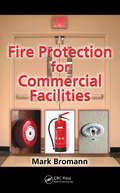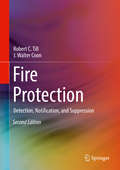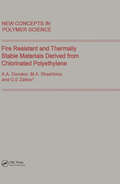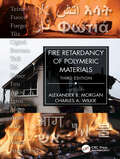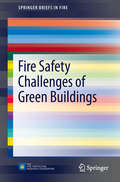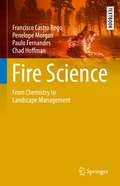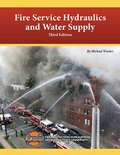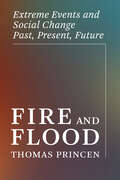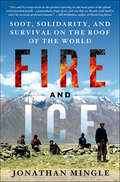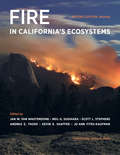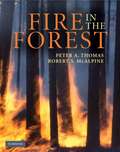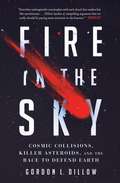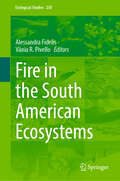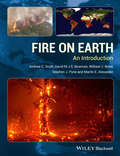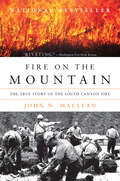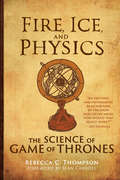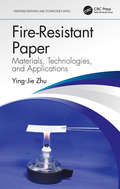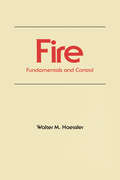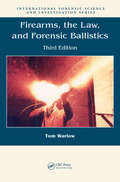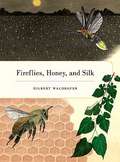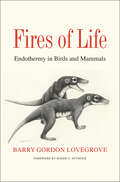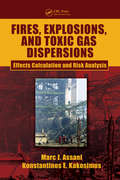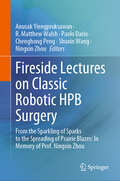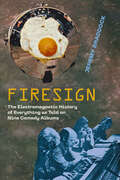- Table View
- List View
Fire Protection for Commercial Facilities
by Mark BromannWhen confronted with a fire protection problem, building management is often desperately short on information and know-how in this critical component of protection for their own facility. It is not that the material is hard to grasp, but that there is so much of it that makes the task seem so daunting. Touching on the many subfields of fire protect
Fire Protection: Detection, Notification, and Suppression
by Robert C. Till J. Walter CoonThe Second Edition of this introduction to fire protection systems is completely revised and updated to offer the student, architect or engineer the basics of fire protection devices and equipment, and how they may be applied to any given project. Fire Protection: Detection, Notification, and Suppression reveals the “nuts and bolts” of fire protection system selection, design and equipment in an applied approach. Whether a mechanical engineer, safety engineer, architect, estimator, fire service personnel, or student studying in these areas, the authors show the pros and the cons of protection systems being proposed, and how they should be compared to one another. It also gives non-fire engineering practitioners a sense of proportion when they are put in a position to select a consultant, and to give a sense of what the consultant may be doing and how a system is being matched to the hazard. Beginning fire protection engineers could also use its language for writing a report about these systems for a client.
Fire Resistant and Thermally Stable Materials Derived from Chlorinated Polyethylene
by A. A. Donskoi M. A. Shashkina G. E ZaikovThis new volume in the book series New Concepts in Polymer Science focuses on the problem of creating materials with reduced combustibility as well as the use of polymeric materials for protection from fire or overheating. The majority of polymeric materials are combustible, which has led to the development of polymers, and materials based on these, with reduced combustibility. However the combustibility degree or their ability to protect from fire or high temperature can be indicated only in particular cases of combustion. In this volume the results of the development of physicochemical bases for creating organic polymeric materials with reduced combustibility, which are capable of protecting against high temperatures are discussed. A presentation of chlorinated polyolefins as organic polymers with reduced combustibility is also given.
Fire Retardancy of Polymeric Materials
by Alexander B. Morgan Charles A. WilkieThe third edition of Fire Retardancy of Polymeric Materials provides a single source for all aspects of this highly challenging field of applied research. This authoritative book covers design and non-fire requirements that drive how these materials are fire protected.Detailed study and consideration of chemistry, physics, materials science, economic issues and fire safety science is necessary to address considerations of mechanical, thermal, environmental, and end-use requirements on top of fire protection means that the field requires. This thoroughly revised new edition continues to offer comprehensive coverage of the scientific approach for those developing fire safe materials. It covers new topics such as bio-based materials, regulatory issues, recycling, newer flame retardant chemical classes, and more details on how to flame retard materials for specific market applications.Written by a team of experts, this book covers the fundamentals of polymer burning and combustion and how to apply fire protection or flame-retardant chemistries to specific material classes and applications. The book is written for material scientists and fire safety scientists who seek to develop new fire safe materials or understand why materials burn in our modern environment.Features Connects fundamentals of material flammability to practical fire safety needs Covers current fire safety requirements and regulations affecting flame retardant selection Provides information on chemical structure-property relationships for flame retardancy Provides practical guidance on how to design fire safe materials for specific fire risk scenarios The new edition is expanded to 32 chapters and all chapters are updated and revised with the newest information
Fire Safety Challenges of Green Buildings
by Brian Meacham Brandon Poole Raymond Cheng Juan EcheverriaEnvironmental concerns and advances in architectural technologies have lead to a greater number of green buildings or buildings with green, eco-friendly elements. However, from a practical standpoint, there is no incident reporting system in the world that tracks data on fire incidents in green buildings. Fire safety objectives are not explicitly considered in most green rating schemes, and green design features have been associated with photovoltaic panels and roof materials, lightweight timber frame buildings, and combustible insulation materials. Fire Safety Challenges of Green Buildings is the result of an extensive global literature review that sought to identify issues related to green building elements or features and ways to ensure those issues are tracked for future improvement. The book identifies actual incidents of fires in green buildings or involving green building elements, points out issues with green building elements that would increase fire risk, clarifies reports and studies that address ways to reduce fire risk in green design elements, and compares research studies that explicitly incorporate fire safety into green building design. The authors also pinpoint gaps and specific research needs associated with understanding and addressing fire risk and hazards with green building design. Using their data, the authors developed a set of matrices relating these green attributes and potential fire hazards. With these comprehensive tools, potential mitigation strategies for addressing the relative increase in fire risk or hazard associated with the green building elements and features have been identified. Fire Safety Challenges of Green Buildings is intended for practitioners as a tool for analyzing building safety issues in green architecture and developing methods for tracking data related to green design elements and their potential hazards. Researchers working in a related field will also find the book valuable.
Fire Science: From Chemistry to Landscape Management (Springer Textbooks in Earth Sciences, Geography and Environment)
by Francisco Castro Rego Paulo Fernandes Penelope Morgan Chad HoffmanThis textbook provides students and academics with a conceptual understanding of fire behavior and fire effects on people and ecosystems to support effective integrated fire management. Through case studies, interactive spreadsheets programmed with equations and graphics, and clear explanations, the book provides undergraduate, graduate, and professional readers with a straightforward learning path. The authors draw from years of experience in successfully teaching fundamental concepts and applications, synthesizing cutting-edge science, and applying lessons learned from fire practitioners. We discuss fire as part of environmental and human health. Our process-based, comprehensive, and quantitative approach encompasses combustion and heat transfer, and fire effects on people, plants, soils, and animals in forest, grassland, and woodland ecosystems from around the Earth. Case studies and examples link fundamental concepts to local, landscape, and global fire implications, including social-ecological systems. Globally, fire science and integrated fire management have made major strides in the last few decades. Society faces numerous fire-related challenges, including the increasing occurrence of large fires that threaten people and property, smoke that poses a health hazard, and lengthening fire seasons worldwide. Fires are useful to suppress fires, conserve wildlife and habitat, enhance livestock grazing, manage fuels, and in ecological restoration. Understanding fire science is critical to forecasting the implication of global change for fires and their effects. Increasing the positive effects of fire (fuels reduction, enhanced habitat for many plants and animals, ecosystem services increased) while reducing the negative impacts of fires (loss of human lives, smoke and carbon emissions that threaten health, etc.) is part of making fires good servants rather than bad masters.
Fire Service Hydraulics and Water Supply
by Michael A. WiederThe ability to identify a sufficient water supply source and use it effectively to control a fire is one of the most basic functions of the fire service. <p><p>This text includes information on the basics of water and water flow, theoretical and practical methods of determining water flow and pressure loss, types of pumps and fire apparatus used to move water, relay pumping operations, fire pump testing, and effectively supplying sprinkler and standpipe systems. <p><p>In addition to new, up-to-date photos and graphics, this 3rd edition discusses recent research on updating friction loss coefficients for modern fire hose. This is also the first edition of this text that includes information and calculations using the Metric System of measurement, where applicable. <p><p>While the intent of the text was meant to address the needs of the higher education market, many fire departments have chosen to use the text for their driver/operator training and promotional testing needs. The information takes the user to a more advanced level of skill and understanding in operating their apparatus than standard driver/operator manuals. <p><p>This text was written to meet all of the National Fire Academy’s FESHE model course curriculum objectives for Fire Protection Hydraulics and Water Supply (C0277) course at the Associate’s Degree level. Some requirements from NFPA 1002, Fire Apparatus Driver/Operator Professional Qualifications (2017 edition) are addressed throughout various portions of the text. <p><p>There are separate units for the chapters that have both U.S. and metric versions. The files are designed so that they may be easily customized to meet local program needs.
Fire and Flood: Extreme Events and Social Change Past, Present, Future (One Planet)
by Thomas PrincenHow extreme events, paradoxically, sow the seeds of positive response—and create opportunities for becoming adaptive to place.Throughout our history we have dealt with extreme events, sometimes adaptively, by coping or even thriving with them, and sometimes disastrously, by repeatedly ignoring their lessons. Now extreme events and disasters are increasing in frequency and severity, and their signals are difficult to read. In Fire and Flood, Thomas Princen argues that the most useful signals may be those coming from fires and floods, both historically and today. This book looks to these past and present events to imagine—and to construct—a regenerative future.Extreme events are much more than just confirmation of climate change. Princen&’s in-depth investigation of disaster response, including our long-term societal response, goes beyond the harm and destruction, the cries for better prevention and protection, and the simplistic formula that, with mere awareness of extreme events, the world will finally &“combat&” climate change. We must learn to read extreme events as signals indicating how adaptive or maladaptive our patterns of extraction, consumption, settlement, and transport are, and, more generally, how sustainable and just our economies are. Understanding these signals will allow us to become adaptive to place and plan for a future living with fires and floods.
Fire and Ice: Soot, Solidarity, and Survival on the Roof of the World
by Jonathan MingleHigh in the Himalayan valley of Zanskar in northwest India sits a village as isolated as the legendary Shangri-La. Long fed by runoff from glaciers and lofty snowfields, Kumik—a settlement of thirty nine mud brick homes—has survived and thrived in one of the world's most challenging settings for a thousand years. But now its people confront an existential threat: chronic, crippling drought, which leaves the village canal dry and threatens to end their ancient culture of farming and animal husbandry. Fire and Ice weaves together the story of Kumik's inspiring response to this calamity with the story of black carbon. Black carbon from inefficient fires - the particulate residue that makes soot dark - is the second largest contributor to global warming after carbon dioxide. It's also a key ingredient of the air pollution that public health experts regard as humanity's greatest environmental health risk worldwide: soot-laden smoke from household hearth fires and outdoor sources combine to kill over seven million people around the world every year. Jonathan Mingle describes the joys and struggles of daily life in the Zanskar Valley, where villagers are buffeted by powerful environmental and economic forces, while also tracing black carbon's dark fingerprints outward from Kumik and around the world. Mingle investigates its impacts on snow, ice, and water from Mt. Everest to California, and the silent health epidemic it fuels from New York to New Delhi. Combining cultural history, detailed reportage, climate and energy science and dramatic storytelling, Fire and Ice is a profound examination of the global challenges of averting climate chaos and lifting billions out of energy poverty and water scarcity. Can Kumik's people come together to reinvent fire, harness what remains of their life-sustaining ice, and reinvigorate their traditions of solidarity, in time to save themselves? Can the rest of us rise to the same challenge? Fire and Ice connects these questions with the work of enterprising scientists, engineers, entrepreneurs and activists around the world, in a narrative that combines mythology, reason, humor, persistence, and hope in a race against a global clock.
Fire in California's Ecosystems
by Jan W. van WagtendonkFire in California’s Ecosystems describes fire in detail—both as an integral natural process in the California landscape and as a growing threat to urban and suburban developments in the state. Written by many of the foremost authorities on the subject, this comprehensive volume is an ideal authoritative reference tool and the foremost synthesis of knowledge on the science, ecology, and management of fire in California. Part One introduces the basics of fire ecology, including overviews of historical fires, vegetation, climate, weather, fire as a physical and ecological process, and fire regimes, and reviews the interactions between fire and the physical, plant, and animal components of the environment. Part Two explores the history and ecology of fire in each of California's nine bioregions. Part Three examines fire management in California during Native American and post-Euro-American settlement and also current issues related to fire policy such as fuel management, watershed management, air quality, invasive plant species, at-risk species, climate change, social dynamics, and the future of fire management. This edition includes critical scientific and management updates and four new chapters on fire weather, fire regimes, climate change, and social dynamics.
Fire in the Forest
by Kelvin Hirsch Peter A. Thomas Peter Hobson Robert S. McalpineHow destructive or beneficial are forest fires to wildlife? Should we be trying to reduce or increase the amount of fire in forests? How are forest fires controlled, and why does this sometimes fail? What effect will climate change have? These and many other questions are answered in this richly illustrated book, written in non-technical language. The journey starts in the long geological history of fire leading up to our present love-hate relationship with it. Exploring the physics of how a single flame burns, the journey continues through how whole forests burn and the anatomy of firestorms. The positive and negative ecological effects of fires are explored, from plants and wildlife to whole landscapes. The journey ends with how fires are controlled, and a look to the future. This book will be of interest to ecologists, biogeographers and anyone with an interest in forest fires and the role they play.
Fire in the Sky: Cosmic Collisions, Killer Asteroids, and the Race to Defend Earth
by Gordon L. DillowCombining history, pop science, and in-depth reporting, a fascinating account of asteroids that hit Earth long ago, and those streaming toward us now, as well as how we are preparing against asteroid-caused catastrophe.One of these days, warns Gordon Dillow, the Earth will be hit by a comet or asteroid of potentially catastrophic size. The only question is when. In the meantime, we need to get much better at finding objects hurtling our way, and if they’re large enough to penetrate the atmosphere without burning up, figure out what to do about them. We owe many of science’s most important discoveries to the famed Meteor Crater, a mile-wide dimple on the Colorado Plateau created by an asteroid hit 50,000 years ago. In his masterfully researched Fire in the Sky, Dillow unpacks what the Crater has to tell us. Prior to the early 1900s, the world believed that all craters—on the Earth and Moon—were formed by volcanic activity. Not so. The revelation that Meteor Crater and others like it were formed by impacts with space objects has led to a now accepted theory about what killed off the dinosaurs, and it has opened up a new field of asteroid observation, which has recently brimmed with urgency. Dillow looks at great asteroid hits of the past and spends time with modern-day asteroid hunters and defense planning experts, including America’s first Planetary Defense Officer. Satellite sensors confirm that a Hiroshima-scale blast occurs in the atmosphere every year, and a smaller, one-kiloton blast every month. While Dillow makes clear that the objects above can be deadly, he consistently inspires awe with his descriptions of their size, makeup, and origins. At once a riveting work of popular science and a warning to not take for granted the space objects hurtling overhead, Fire in the Sky is, above all, a testament to our universe’s celestial wonders.
Fire in the South American Ecosystems (Ecological Studies #250)
by Alessandra Fidelis Vânia R. PivelloThe incidence of anthropogenic fires in South America has increased lately, and fire effects on the biodiversity and ecosystem services are of great concern. On the other hand, natural fires have been present in the continent for thousands of years, acting as an evolutionary driver of vegetation and fauna. Therefore, several ecosystems in South America are fire-prone due to their evolutionary history, while those that have not evolved under frequent fires are fire-sensitive. At the same time, as humans increase fire frequency in some environments they try to banish fire from others, and such anthropogenic fire regimes have enormous consequences for biota, ecosystem services and the environment. This book will address the various South American ecosystems that benefit from the presence of fire, but also those that are harmed by fire. The effects of fire on plant and animal biodiversity of the main South American ecosystems will be presented and discussed considering current trends in climate and land use change, bringing understanding about when and how fire should or should not be used to benefit nature and humans. Options for fire planning and management will be highlighted, especially considering the reduction of wildfire risk and the conservation of biodiversity and natural resources. This broad comprehension of the fire issue in South America will support wise decisions by environmental analysts, conservation managers and public policy makers.
Fire on Earth
by William J. Bond Stephen J. Pyne Andrew C. Scott Martin E. Alexander David M. BowmanEarth is the only planet known to have fire. The reason is both simple and profound: fire exists because Earth is the only planet to possess life as we know it. Fire is an expression of life on Earth and an index of life's history. Few processes are as integral, unique, or ancient.Fire on Earth puts fire in its rightful place as an integral part of the study of geology, biology, human history, physics, and global chemistry. Fire is ubiquitous in various forms throughout Earth, and belongs as part of formal inquiries about our world. In recent years fire literature has multiplied exponentially; dedicated journals exist and half a dozen international conferences are held annually. A host of formal sciences, or programs announcing interdisciplinary intentions, are willing to consider fire. Wildfire also appears routinely in media reporting.This full-colour text, containing over 250 illustrations of fire in all contexts, is designed to provide a synthesis of contemporary thinking; bringing together the most powerful concepts and disciplinary voices to examine, in an international setting, why planetary fire exists, how it works, and why it looks the way it does today. Students, lecturers, researchers and professionals interested in the physical, ecological and historical characteristics of fire will find this book, and accompanying web-based material, essential reading for undergraduate and postgraduate courses in all related disciplines, for general interest and for providing an interdisciplinary foundation for further study.A comprehensive approach to the history, behaviour and ecological effects of fire on earthTimely introduction to this important subject, with relevance for global climate change, biodiversity loss and the evolution of human culture.Provides a foundation for the interdisciplinary field of Fire ResearchAuthored by an international team of leading experts in the fieldAssociated website provides additional resources
Fire on the Mountain: The True Story Of The Sourth Canyon Fire
by John N MacleanIn 1994, a wildfire on Colorado's Storm King Mountain was wrongly identified at the outset as occurring in South Canyon.This unintentional, seemingly minor human error was the first in a string of mistakes that would be compounded into one of the greatest tragedies in the annals of firefighting. Before it was done, fourteen courageous firefighters—men and women, hotshots, smoke jumpers, and helicopter crew—would lose their lives battling the deadly so-called South Canyon blaze.John N. Maclean's award-winning national bestseller Fire on the Mountain is a stunning reconstruction of the killer conflagration and its aftermath—a page-turning true adventure of nature at its most unforgiving, and a powerful, indelible portrait of a unique breed of heroes who regularly and without question place their lives on the line.
Fire, Ice, and Physics: The Science of Game of Thrones (The\mit Press Ser.)
by Rebecca C. ThompsonExploring the science in George R. R. Martin's fantastical world, from the physics of an ice wall to the genetics of the Targaryens and Lannisters.Game of Thrones is a fantasy that features a lot of made-up science—fabricated climatology (when is winter coming?), astronomy, metallurgy, chemistry, and biology. Most fans of George R. R. Martin's fantastical world accept it all as part of the magic. A trained scientist, watching the fake science in Game of Thrones, might think, “But how would it work?” In Fire, Ice, and Physics, Rebecca Thompson turns a scientist's eye on Game of Thrones, exploring, among other things, the science of an ice wall, the genetics of the Targaryen and Lannister families, and the biology of beheading. Thompson, a PhD in physics and an enthusiastic Game of Thrones fan, uses the fantasy science of the show as a gateway to some interesting real science, introducing GOT fandom to a new dimension of appreciation. Thompson starts at the beginning, with winter, explaining seasons and the very elliptical orbit of the Earth that might cause winter to come (or not come). She tells us that ice can behave like ketchup, compares regular steel to Valyrian steel, explains that dragons are “bats, but with fire,” and considers Targaryen inbreeding. Finally she offers scientific explanations of the various types of fatal justice meted out, including beheading, hanging, poisoning (reporting that the effects of “the Strangler,” administered to Joffrey at the Purple Wedding, resemble the effects of strychnine), skull crushing, and burning at the stake. Even the most faithful Game of Thrones fans will learn new and interesting things about the show from Thompson's entertaining and engaging account. Fire, Ice, and Physics is an essential companion for all future bingeing.
Fire-Resistant Paper: Materials, Technologies, and Applications (Emerging Materials and Technologies)
by Ying-Jie ZhuEven in today's electronic information age, traditional paper is a multi-purpose product that continues to be indispensable to people’s daily work and lives. While paper is a valued product, the paper industry contributes to environmental pollution and consumption of natural resources, and the organic substances out of which traditional paper is made render it highly flammable and easy to burn. This book introduces a new technology to develop environmentally friendly fire-resistant paper using highly flexible ultralong hydroxyapatite nanowires and discusses applications and potential for commercialization. Discusses characterization, properties, and synthesis of ultralong hydroxyapatite nanowires and compares them with cellulose fibers Describes steps to design and create fire-resistant paper Covers a variety of function-based fire-resistant paper, including antibacterial, magnetic, photoluminescent, among others Examines a host of applications, such as paper for anti-counterfeiting, encryption and decryption, environmental, energy, and biomedical uses Considers commercialization potential and future prospects This book is aimed at materials scientists, chemical engineers, industrial chemists, and other researchers from across the scientific and engineering disciplines interested in the development of this exciting alternative to traditional paper.
Fire: Fundamentals and Control
by Walter M. HaesslerThis book is devoted to the complex nature of fire, the intricasies of the combustion process, the influence of chemical and physical properties of fuels, and the proper means of fire extinguishment. It lists sequentially the various factors in the combustion process.
Firearms, the Law, and Forensic Ballistics
by Tom WarlowWhile gun design has undergone only minimal change over the centuries, investigative tools surrounding firearm use have grown significantly in sophistication. Now in its third edition, Firearms, the Law, and Forensic Ballistics has been updated to reflect recently published research and new technology developed since the last volume. Beginning with
Fireflies, Honey, and Silk
by Gilbert WaldbauerThis enchanting book is a highly entertaining exploration of the myriad ways insects have enriched our lives--culturally, economically, and aesthetically. Writer describes in loving, colorful detail how many of the valuable products insects have given us are made, how they were discovered, and how they have been used through time and across cultures.
Fires of Life: Endothermy in Birds and Mammals
by Barry Gordon LovegroveA groundbreaking argument on how endothermy—arguably the most important innovation in vertebrate evolution—developed in birds and mammals&“Vividly narrated and illustrated. . . . Provocative and fascinating for specialists and lay readers alike.&”—Southeastern Naturalist This pioneering work investigates why endothermy, or &“warm-bloodedness,&” evolved in birds and mammals, despite its enormous energetic costs. Arguing that single-cause hypotheses to explain the origins of endothermy have stalled research since the 1970s, Barry Gordon Lovegrove advances a novel conceptual framework that considers multiple potential causes and integrates data from the southern as well as the northern hemisphere. Drawing on paleontological data; research on extant species in places like the Karoo, Namaqualand, Madagascar, and Borneo; and novel physiological models, Lovegrove builds a compelling new explanation for the evolution of endothermy. Vividly narrated and illustrated, this book stages a groundbreaking argument that should prove provocative and fascinating for specialists and lay readers alike.
Fires, Explosions, and Toxic Gas Dispersions: Effects Calculation and Risk Analysis
by Marc J. Assael Konstantinos E. KakosimosToday's risk analysis is a very challenging field, and a solid understanding of the calculations procedure associated with it is essential for anyone involved. Fires, Explosions, and Toxic Gas Dispersions: Effects Calculation and Risk Analysis provides an overview of the methods used to assess the risk of fires, explosions, and toxic gas dispersion
Fireside Lectures on Classic Robotic HPB Surgery: From the Sparkling of Sparks to the Spreading of Prairie Blazes: In Memory of Prof. Ningxin Zhou
by Paolo Dario Anusak Yiengpruksawan R. Matthew Walsh Chenghong Peng Shuxin Wang Ningxin ZhouThis book presents a collection of case reviews on robotic HPB (Hepato-pancreato-biliary) surgeries contributed by distinguished surgical experts and robotics engineers. Each case is accompanied by photographs and discussions to facilitate understanding of the presented projects and techniques. The book not only presents practical robotic HPB surgery techniques, but also offers experts’ reflections and perspectives on the future of robotic surgeries and surgical robotics. Serving as a collection in memory of Prof. Ningxin Zhou, a pioneer of robotic HPB surgery in China, it illustrates the development and success of Prof. Zhou’s study of surgical robotics and his explorations in combining surgery with engineering. The book is a valuable resource for practitioners and researchers in the medical field and engineering alike.
Firesign: The Electromagnetic History of Everything as Told on Nine Comedy Albums
by Jeremy BraddockA cultural clearinghouse of the American 1960s and '70s told through the story of the period's most important forgotten comedy group. This expansive book reclaims the Firesign Theatre (hazily remembered as a comedy act for stoners) as critically engaged artists working in the heart of the culture industry at a time of massive social and technological change. At the intersection of popular music, sound and media studies, cultural history, and avant-garde literature, Jeremy Braddock explores how this inventive group made the lowbrow comedy album a medium for registering the contradictions and collapse of the counterculture, and traces their legacies in hip-hop turntablism, computer hacking, and participatory fan culture. He deploys a vast range of material sources, drawing on numerous interviews and writing in tune with the group's obsessive and ludic reflections—on multitrack recording, radio, television, cinema, early artificial intelligence, and more—to focus on Firesign's work in Los Angeles from 1967 to 1975. This ebullient act of media archaeology reveals Firesign Theatre as authors of a comic utopian pessimism that will inspire twenty-first-century recording arts and urge us to engage the massive technological changes of our own era.
Fireworks! (Fountas & Pinnell LLI Purple #Level U)
by Paul WinterThe Sound of Celebration. A high-pitched whistle pierces the quiet night, and the spectators hold their breath. Soon a resounding boom will rock the ground beneath their feet, and the sky will light up in a dazzling display of color. For millennia, fireworks have held the world's attention. Discover how an accidental explosion set off a love of fireworks that continues to this day.
